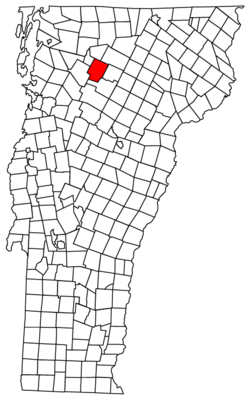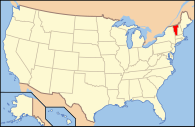Johnson is a town in Lamoille County, Vermont, United States. The population was 3,491 at the 2020 census.[5] The town is home to Northern Vermont University-Johnson, a part the Vermont State Colleges system. The Vermont Studio Center is located in the village of Johnson. Since 1842, the town has been the home to Johnson Woolen Mills.
Johnson, Vermont | |
|---|---|
 | |
 Located in Lamoille County, Vermont | |
 Location of Vermont within the U.S.A. | |
| Coordinates: 44°38′38″N 72°40′52″W / 44.64389°N 72.68111°W[1] | |
| Country | United States |
| State | Vermont |
| County | Lamoille |
| Chartered | 1792 (Vermont)[2] |
| Communities | Johnson East Johnson |
| Area | |
| • Total | 45.1 sq mi (116.8 km2) |
| • Land | 44.7 sq mi (115.8 km2) |
| • Water | 0.4 sq mi (1.0 km2) 0.84% |
| Population (2020)[4] | |
| • Total | 3,491 |
| • Density | 78/sq mi (30.1/km2) |
| • Households | 1,349 |
| • Families | 750 |
| Time zone | UTC-5 (EST) |
| • Summer (DST) | UTC-4 (EDT) |
| ZIP code | 05656 |
| Area code | 802 |
| GNIS feature ID | 1462129 |
| Website | www |
Geography
editJohnson is in the center of Lamoille County, in the valley of the Lamoille River, with the Green Mountains rising to the north and the south of the river. The village of Johnson is in the center of the town, where the Gihon River joins the Lamoille from the northeast. Vermont Route 15 crosses the center of the town, following the Lamoille River; the highway leads southeast 5 miles (8 km) to Hyde Park, the Lamoille County shire town, and west 9 miles (14 km) to Jeffersonville in the town of Cambridge. Vermont Route 100C leads northeast from Johnson village 4.5 miles (7.2 km) to Vermont Route 100 in North Hyde Park.
According to the United States Census Bureau, the town of Johnson has a total area of 45.1 square miles (116.8 km2), of which 0.4 square miles (1.0 km2), or 0.84%, are water.[3]
Climate
edit| Climate data for Johnson 2 N, Vermont, 1991–2020 normals, 2013-2020 snowfall: 980ft (299m) | |||||||||||||
|---|---|---|---|---|---|---|---|---|---|---|---|---|---|
| Month | Jan | Feb | Mar | Apr | May | Jun | Jul | Aug | Sep | Oct | Nov | Dec | Year |
| Mean daily maximum °F (°C) | 24.1 (−4.4) |
27.6 (−2.4) |
36.1 (2.3) |
50.3 (10.2) |
63.4 (17.4) |
71.2 (21.8) |
75.9 (24.4) |
74.3 (23.5) |
67.7 (19.8) |
54.4 (12.4) |
41.6 (5.3) |
30.3 (−0.9) |
51.4 (10.8) |
| Daily mean °F (°C) | 14.4 (−9.8) |
17.1 (−8.3) |
26.3 (−3.2) |
40.0 (4.4) |
52.7 (11.5) |
61.2 (16.2) |
65.8 (18.8) |
64.1 (17.8) |
56.9 (13.8) |
45.0 (7.2) |
33.7 (0.9) |
22.1 (−5.5) |
41.6 (5.3) |
| Mean daily minimum °F (°C) | 4.6 (−15.2) |
6.6 (−14.1) |
16.4 (−8.7) |
29.7 (−1.3) |
41.9 (5.5) |
51.2 (10.7) |
55.6 (13.1) |
53.8 (12.1) |
46.0 (7.8) |
35.6 (2.0) |
25.7 (−3.5) |
13.9 (−10.1) |
31.7 (−0.1) |
| Average precipitation inches (mm) | 2.81 (71) |
2.38 (60) |
2.77 (70) |
3.79 (96) |
5.04 (128) |
4.65 (118) |
4.49 (114) |
4.37 (111) |
4.04 (103) |
5.16 (131) |
3.74 (95) |
3.59 (91) |
46.83 (1,188) |
| Average snowfall inches (cm) | 24.0 (61) |
30.6 (78) |
22.7 (58) |
6.0 (15) |
0.8 (2.0) |
0.0 (0.0) |
0.0 (0.0) |
0.0 (0.0) |
0.0 (0.0) |
0.6 (1.5) |
14.5 (37) |
20.0 (51) |
119.2 (303.5) |
| Source 1: NOAA[6] | |||||||||||||
| Source 2: XMACIS (snowfall)[7] | |||||||||||||
Town name
editThe town is named for the American jurist, statesman and educator William Samuel Johnson.[8] The town and a part of neighboring Cambridge were together known as the King's College Tract, having been created by a royal charter of British King George III in 1774. The King's College Tract was reserved for the eventual expansion of Kings College in New York, today's Columbia University. After the U.S. Declaration of Independence, Vermont's Council of Censors granted the town to Johnson in 1785.
Demographics
edit| Census | Pop. | Note | %± |
|---|---|---|---|
| 1790 | 93 | — | |
| 1800 | 341 | 266.7% | |
| 1810 | 494 | 44.9% | |
| 1820 | 778 | 57.5% | |
| 1830 | 1,079 | 38.7% | |
| 1840 | 1,410 | 30.7% | |
| 1850 | 1,381 | −2.1% | |
| 1860 | 1,526 | 10.5% | |
| 1870 | 1,558 | 2.1% | |
| 1880 | 1,495 | −4.0% | |
| 1890 | 1,462 | −2.2% | |
| 1900 | 1,391 | −4.9% | |
| 1910 | 1,526 | 9.7% | |
| 1920 | 1,478 | −3.1% | |
| 1930 | 1,378 | −6.8% | |
| 1940 | 1,420 | 3.0% | |
| 1950 | 1,527 | 7.5% | |
| 1960 | 1,478 | −3.2% | |
| 1970 | 1,927 | 30.4% | |
| 1980 | 2,581 | 33.9% | |
| 1990 | 3,156 | 22.3% | |
| 2000 | 3,274 | 3.7% | |
| 2010 | 3,446 | 5.3% | |
| 2020 | 3,491 | 1.3% | |
| U.S. Decennial Census[9] | |||
As of the census[10] of 2000, there were 3,274 people, 1,170 households, and 669 families residing in the town. The population density was 72.6 people per square mile (28.0/km2). There were 1,263 housing units at an average density of 28.0 per square mile (10.8/km2). The racial makeup of the town was 96.58% White, 0.61% Black or African American, 0.43% Native American, 0.67% Asian, 0.31% from other races, and 1.41% from two or more races. Hispanic or Latino of any race were 0.73% of the population.
There were 1,170 households, out of which 30.8% had children under the age of 18 living with them, 41.4% were couples living together and joined in either marriage or civil union, 10.8% had a female householder with no husband present, and 42.8% were non-families. 28.2% of all households were made up of individuals, and 8.5% had someone living alone who was 65 years of age or older. The average household size was 2.43 and the average family size was 2.99.
In the town, the population was spread out, with 21.6% under the age of 18, 26.4% from 18 to 24, 25.4% from 25 to 44, 18.2% from 45 to 64, and 8.5% who were 65 years of age or older. The median age was 26 years. For every 100 females, there were 103.7 males. For every 100 females age 18 and over, there were 102.2 males.
The median income for a household in the town was $31,343, and the median income for a family was $38,224. Males had a median income of $28,257 versus $20,610 for females. The per capita income for the town was $15,014. About 13.8% of families and 18.9% of the population were below the poverty line, including 21.6% of those under age 18 and 11.7% of those age 65 or over.
Notable people
edit- Amalia Post (1836–1897), suffragist
- Victor Swenson (1936–2019), educator
References
edit- ^ "Town of Johnson". Geographic Names Information System. United States Geological Survey, United States Department of the Interior. Retrieved May 15, 2009.
- ^ "Johnson Namesake". Archived from the original on April 6, 2012. Retrieved December 20, 2011.
- ^ a b "2019 U.S. Gazetteer Files". United States Census Bureau. Retrieved February 10, 2021.
- ^ "Total Population: 2018 Census DEC Summary File 1 (P1), Johnson town, Lamoille County, Vermont". data.census.gov. U.S. Census Bureau. Retrieved February 10, 2021.
- ^ "Census - Geography Profile: Johnson town, Lamoille County, Vermont". Retrieved December 31, 2021.
- ^ "Johnson 2 N, Vermont 1991-2020 Monthly Normals". Retrieved December 15, 2023.
- ^ "xmACIS". National Oceanic and Atmospheric Administration. Retrieved December 15, 2023.
- ^ Swift, Esther Monroe. Vermont Place Names: Footprints of History. The Stephen Greene Press: 1996 ISBN 0-8289-0291-7
- ^ "U.S. Decennial Census". United States Census Bureau. Retrieved May 16, 2015.
- ^ "U.S. Census website". United States Census Bureau. Retrieved January 31, 2008.
- Rodgers, Steve. Country Towns of Vermont. McGraw-Hill: 1998. ISBN 1-56626-195-3.
- Strickland, Ron. Vermonters: Oral Histories from Down Country to the Northeast Kingdom. University Press of New England: 1986. ISBN 0-87451-867-9.
